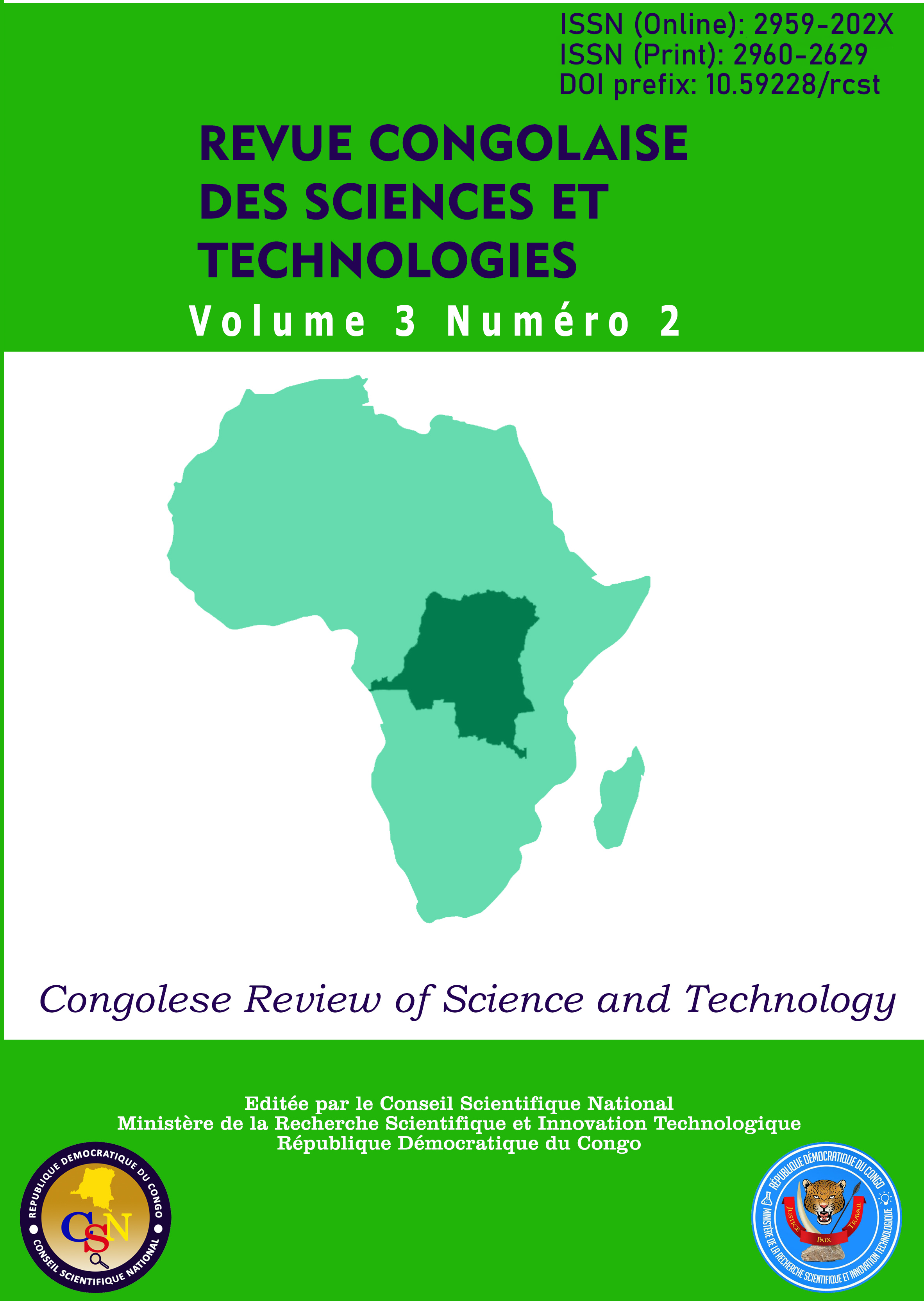Community determinants of non-vaccination and incomplete vaccination of children aged 0 to 11 months in the Kabimba health area, in the Democratic Republic of Congo
Main Article Content
Abstract
The reduction in vaccination rates currently reported in the Democratic Republic of Congo (DRC) risks exposing children to deadly diseases.
Therefore, this study aims to identify the determinants of non-vaccination and complete non-vaccination of children aged 0-11 months in the
Kabimba-Uvira health area. This is a cross-sectional study with an analytical aim carried out in the Uvira health zone, specifically in the
Kabimba health area. Our study population was 476 women with a child aged 0-11 months, from whom a stratified probability sample of 213
mothers was drawn. Data collection was done using a self-administered questionnaire, and data analysis was carried out using SPSS 25
software. The study demonstrated that the determinants of non-vaccination of children aged 0-11 months were: the environment of residence
(long distance between the environment and the health structure); gender and lack of knowledge about the benefits of vaccination. Regarding
the determinants of complete non-vaccination, unfavorable opinions (or lack of support) of children's fathers regarding vaccination were
identified. Mass vaccination campaigns (door to door) remain a strategy and a priority in the environment of our study. In addition, raising
awareness among parents about the benefits of vaccination cannot be ruled out.
Article Details

This work is licensed under a Creative Commons Attribution-NonCommercial-ShareAlike 4.0 International License.
References
Akoto, E. M. (s. d.). Se soigner aujourd’hui en
Afrique de l’Ouest : Pluralisme thérapeutique
entre traditions et modernité (Bénin, Côte
d’Ivoire et Mali). Consulté 14 mai 2024, sur
https://cir.nii.ac.jp/crid/1130000798175854848.
Babalola, S. (2009). Determinants of the Uptake of
the Full Dose of Diphtheria–Pertussis–Tetanus
Vaccines (DPT3) in Northern Nigeria : A
Multilevel Analysis. Maternal and Child
Health Journal, 13(4), 550‑ 558.
https://doi.org/10.1007/s10995-008-0386-5
Baonga Ba Pouth, S. F., Kazambu, D., Delissaint, D.,
& Kobela, M. (2014). Couverture vaccinale et
facteurs associés à la non complétude vaccinale
des enfants de 12 à 23 mois du district de santé
de Djoungolo-Cameroun en 2012. Pan African
Medical Journal, 17.
https://doi.org/10.11604/pamj.2014.17.91.2792
Bobossi-Serengbé, G., Fioboy, R., Ndoyo, J., &
Nakouné, E. (2014). Les occasions manquées
de vaccination chez les enfants de 0 à 11
mois à Bangui. Journal de Pédiatrie et de
Puériculture, 27(6), 289‑ 293.
https://doi.org/10.1016/j.jpp.2014.08.010
Cambell, S. (2006, février 1). Clinical update.
Increasing immunisation coverage in
developing countries. Primary Health Care. 16
(1). EBSCOhost.
https://doi.org/10.7748/phc2006.02.16.1.25.c59
Coulibaly, C. A. (2022). Facteurs associés au statut
vaccinal des enfants de 12 à 23 mois à Farakala
et Kapala du district sanitaire de Sikasso. MaliSanté Publique, 23‑ 29.
https://doi.org/10.53318/msp.v12i2.2612
Danielsson, N., Fakakovikaetau, T., & Szegedi, E.
(2009). Improved immunization practices
reduce childhood hepatitis B infection in
Tonga. Vaccine, 27(33), 4462‑ 4467.
https://doi.org/10.1016/j.vaccine.2009.05.051
Ezeh, A., Bankole, A., Cleland, J., García-Moreno,
C., Temmerman, M., & Ziraba, A. K. (2016).
Burden of Reproductive Ill-Health. In Disease
Control Priorities, Third Edition (Volume 2) :
Reproductive, Maternal, Newborn, and Child
Health (p. 25-50). The World Bank.
https://doi.org/10.1596/978-1-4648-0348-
_ch2.
Félicitée, N., Hermann, N. D., Andreas, C., Evelyn,
M., Guy, W., Michel, M., Baptiste, B. J., &
Olivier, K. N. P. (2018). Déterminants et
Raisons de Non Vaccination Complète des
Enfants Hospitalisés dans deux Hôpitaux de
Référence Pédiatrique à Yaoundé. Inédit.
Gebeyehu, N. A., Gesese, M. M., Tegegne, K. D.,
Kebede, Y. S., Kassie, G. A., Mengstie, M. A.,
Zemene, M. A., Moges, N., Bantie, B., Feleke,
S. F., Dejenie, T. A., Abebe, E. C., Anley, D.
T., Dessie, A. M., Bayih, W. A., & Adella, G.
A. (2023). Early marriage and its associated
factors among women in Ethiopia : Systematic
reviews and meta-analysis. Plos One, 18(11),
e0292625.
https://doi.org/10.1371/journal.pone.0292625
Jani, J. V., De Schacht, C., Jani, I. V., & Bjune, G.
(2008). Risk factors for incomplete vaccination
and missed opportunity for immunization in
rural Mozambique. BMC Public Health, 8(1),
https://doi.org/10.1186/1471-2458-8-161
Jonathan, G. E., & Stoltenberg, J. (2013). A tipping
point for change : Saving millions of additional
lives in 2013 and beyond. The Lancet,
(9864), 350‑ 352.
https://doi.org/10.1016/S0140-6736(13)60111-
Kaberuka, C. S., Abintegenke, A. I., Mutazihara, J.-
C. B., & Ringeze, C. M. (2023). Problématique
des groupes résistant à la vaccination de masse
des enfants de 0 à 5 ans dans l’aire de santé
Kiziba, Zone de Santé de Nyiragongo à Goma/
RDC. British Journal of Multidisciplinary and
Advanced Studies, 4(2), Article 2.
https://doi.org/10.37745/bjmas.2022.0172
La Fond, A., Kanagat, N., Steinglass, R., Fields, R.,
Sequeira, J., & Mookherji, S. (2015). Drivers of
routine immunization coverage improvement in
Africa : Findings from district-level case
studies. Health Policy and Planning, 30(3),
‑ 308.
https://doi.org/10.1093/heapol/czu011
Lane, S., MacDonald, N. E., Marti, M., & Dumolard,L. (2018). Vaccine hesitancy around the globe :
Analysis of three years of WHO/UNICEF Joint
Reporting Form data-2015–2017. Vaccine,
(26), 3861‑ 3867.
https://doi.org/10.1016/j.vaccine.2018.03.063
Lee, B. Y., & Haidari, L. A. (2017). The importance
of vaccine supply chains to everyone in the
vaccine world. Vaccine, 35(35, Part A),
‑ 4479.
https://doi.org/10.1016/j.vaccine.2017.05.096
Mukalay A.W.M., Mushadi Kimpodjongo, G.,
Mwanza Numbi, V., Tshikala Kosa, B., Chuy
Kalombola, D., Kalenga, J., & Kalenga
Muenze Kayamba, P. (2021). Déterminants de
la vaccination complète des enfants d’une aire
de santé de la ville de Lubumbashi en
République Démocratique du Congo. Revue
d’Épidémiologie et de Santé Publique, 69,
S72‑ S73.
https://doi.org/10.1016/j.respe.2021.04.125
Mumbere, K. (s. d.). Problématique de gestion de
latrines dans les institutions supérieures et
universitaires. Mémoire Online. Consulté 15
mai 2024, à l’adresse
https://www.memoireonline.com/01/13/6839/P
roblematique-de-gestion-des-latrines-dans-lesinstitutions-superieures-et-universitaires.html
OMS. (2020). Chronologie de l’action de l’OMS face
à la COVID-19. Consulté 15 février 2024, à
l’adresse https://www.who.int/fr/news/item/29-
-2020-covidtimeline
Rainey, J. J., Watkins, M., Ryman, T. K., Sandhu, P.,
Bo, A., & Banerjee, K. (2011). Reasons related
to non-vaccination and under-vaccination of
children in low and middle income countries :
Findings from a systematic review of the
published literature, 1999–2009. Vaccine,
(46), 8215‑ 8221.
https://doi.org/10.1016/j.vaccine.2011.08.096
Ruducha, J., Mann, C., Singh, N. S., Gemebo, T. D.,
Tessema, N. S., Baschieri, A., Friberg, I.,
Zerfu, T. A., Yassin, M., Franca, G. A., &
Berman, P. (2017). How Ethiopia achieved
Millennium Development Goal 4 through
multisectoral interventions : A Countdown to
case study. The Lancet Global Health,
(11), e1142‑ e1151.
https://doi.org/10.1016/S2214-109X(17)30331-
Santoni, F. (2001). Le programme élargi de
vaccination : 25 ans demain. Inédit.
Seck, I., Diop, B., Mbacké Leye, M. M., Mbacké
Mboup, B., Ndiaye, A., Seck, P. A., Doucoure,
A., Ba, T. A., Diongue, M., Faye, A., & Tal
Dia, A. (2016). Déterminants sociaux de la
couverture vaccinale de routine des enfants de
à 23 mois dans la région de Kaolack,
Sénégal. Santé Publique, 28(6), 807‑ 815. https://doi.org/10.3917/spub.166.0807
Smith, P. J., Humiston, S. G., Parnell, T., Vannice, K.
S., & Salmon, D. A. (2010). The Association
between Intentional Delay of Vaccine
Administration and Timely Childhood
Vaccination Coverage. Public Health Reports,
(4), 534‑ 541.
https://doi.org/10.1177/003335491012500408
Tilahun, B., Mekonnen, Z., Sharkey, A.,
Shahabuddin, A., Feletto, M., Zelalem, M., &
Sheikh, K. (2020). What we know and don’t
know about the immunization program of
Ethiopia : A scoping review of the literature.
BMC Public Health, 20(1), 1365.
https://doi.org/10.1186/s12889-020-09304-1
UNFPA. (2021, septembre 17). UNFPA République
Démocratique Du Congo.
UNICEF. (2020). La Situation des enfants dans le
monde 2019 : Enfants, nourriture et nutrition -
Bien grandir dans un monde en mutation.
Verrier, F., de Lauzanne, A., Diouf, J.-B. N., Zo, A.
Z., Ramblière, L., Herindrainy, P., Sarr, F. D.,
Sok, T., Vray, M., Collard, J.-M., Borand, L.,
Kermorvant-Duchemin, E., DelarocqueAstagneau, E., Guillemot, D., Huynh, B.-T., &
for the Bacterial Infections and AntibioticResistant Diseases Among Young Children in
Low-Income Countries (BIRDY) Study Group.
(2023). Vaccination Coverage and Risk Factors
Associated With Incomplete Vaccination
Among Children in Cambodia, Madagascar,
and Senegal. Open Forum Infectious Diseases,
(4), ofad136.

